Boot: 2019-2020 Fischer Ranger Free 130
Stated Flex: 130
Available Sizes: 25.5 – 30.5 (half sizes only)
Stated Last (size 26.5): 99 mm
Stated Range of Motion: 55°
Stated Forward Lean: 16° (18° with removable spoiler)
Size Tested: 27.5
Stated Boot Sole Length: 315 mm
Blister’s Measured Weight (27.5):
- Shells, no Liners: 1230 & 1236 g
- Liners, no Footbeds: 357 & 354 g
- Shells + Liners = 1587 & 1590 g
Buckles: 4 micro-adjustable aluminum
Powerstrap: 50 mm Velcro
Shell Material:
- Cuff: Carbon-Reinforced Grilamid
- Shoe / Clog: Grilamid
Soles: GripWalk w/ Vibram rubber (replaceable); Alpine soles available separately
Binding Compatibility: GripWalk and MNC bindings
Tech Fittings: Dynafit Certified
MAP: $799
Skis / Bindings Used:
- 189 cm DPS Alchemist Wailer 106 / Salomon STH2 16
- 190 cm Moment Bibby Tour / Fritschi Tecton 12
- 186 cm Black Diamond Helio 116 Carbon / Fritschi Vipec
- 183 cm Black Crows Corvus Freebird / Marker Kingpin
Test Locations: Chugach Range & Alyeska Resort, AK; Chamonix, France; Taos, NM
Reviewers:
- Paul Forward: 6′, 190 lbs
- Alex Mueller: 6′, ~170 lbs
Days Tested: ~25
[Note: Our review was conducted on the 18/19 Ranger Free 130, which was not changed for 19/20, apart from graphics.]
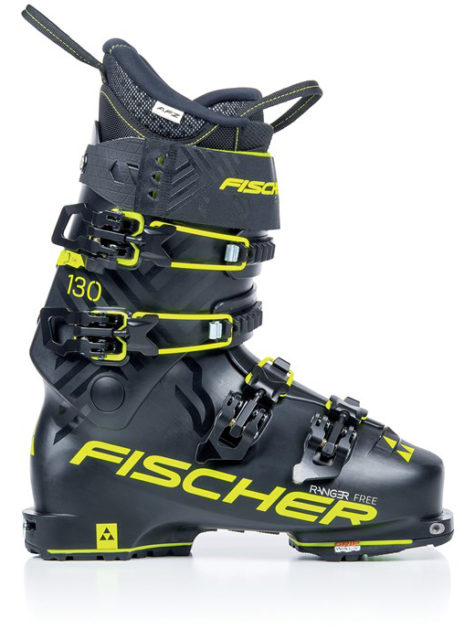
Intro
For the 18/19 season, it seems as though just about every major boot company came out with some kind of lightweight, “130 Flex” boot with a walk mode and other touring specific features.
This category of boots is getting lighter while still claiming to maintain performance very similar to full alpine boots — which was unheard of just a few years ago.
For 18/19, Fischer introduced the Ranger Free series, which includes the men’s Ranger Free 130, 120, and 100 and the women’s My Ranger Free 110 and 90.
I’ve been testing the Ranger Free 130 inbounds, when sled-accessed skiing, and when touring around the Chugach mountains. Reviewer Alex Mueller has also spent time in the Ranger Free 130 in Chamonix and around New Mexico, and we’ve updated this review with his thoughts on the boot.
Here’s what Fischer says about the Fischer Ranger Free 130:
“Ranger Free 130 – an ultralight freeride boot that is a stable, high performance boot on fast groomed slopes, while also offering serious tour walkability.”
“When the best downhills are waiting on the other side of a long uphill, the Ranger Free 130’s excellent walkability is a skier’s best friend. Switch the integrated cuff lever to Walk mode for an excellent range of forward motion when walking or touring.”
Weight + Comparisons
For reference, below are a number of our measured weights for some other notable boots (keep in mind the size differences). Our measured weights show the size of boot, then the weight of each boot + the weight of each liner, then the total weight for shells + liners, listed in grams:
Scarpa Maestrale RS (24.5 / 25.0): 1053 & 1057 + 244 & 245 = 1297 & 1302 g
Tecnica Zero G Tour Pro (26.5): 1099 & 1100 + 210 & 211 = 1309 & 1311 g
Salomon MTN Explore (26.5): 1126 & 1135 + 281 & 281 = 1407 & 1416 g
Atomic Hawx Ultra XTD 130 (26.5): 1128 & 1127 + 300 & 305 = 1428 & 1432 g
Scarpa Maestrale XT (26.5 / 27.0): 1258 & 1258 + 247 & 252 = 1505 & 1510 g
Head Kore 1 (26.5): 1132 & 1136 + 392 & 393 = 1524 & 1527 g
Salomon S/Lab MTN (26.5): 1257 & 1246 + 288 & 303 = 1545 & 1549 g
Fischer Ranger Free 130 (26.5): 1204 & 1204 + 348 & 351 = 1552 & 1555 g
Roxa R3 130 T.I. (27.5): 1341 & 1348 + 263 & 262 = 1604 & 1610 g
Salomon QST Pro TR 130 (26.5): 1389 & 1391 + 273 & 274 = 1662 & 1665 g
Nordica Strider Pro 130 DYN (27.5): 1445 & 1440 + 363 & 373 = 1808 & 1813
Lange XT Free 130 LV (27.5): 1472 & 1473 + 376 & 376 = 1848 & 1849 g
Full Tilt Ascendant (27.5): 1613 & 1615 & + 3018 & 311 = 1921 & 1962 g
Tecnica Cochise 130 DYN (25.5): 1493 & 1496 + 440 & 441 = 1933 & 1937 g
Liner
Paul: Overall, I think Fischer did a really good job with the liner. The tongue is made with stiff plastic reinforcement like a nice alpine boot liner, which provides a bit more comfort and support (though the liner is still relatively light at around 350 grams). The liner’s heel is nicely contoured and complements the shell’s heel pocket well. Similarly, the overall volume and thickness of the liner strikes a nice balance — it’s just plush enough to provide good warmth and comfort without feeling mushy and imprecise. The liners are heat-moldable, and I did a quick in-home heat mold using the rice-in-sock method. Along with Scarpa’s Intuition-branded liners, these Ranger liners are among the best stock liners I’ve used in boots of this class.
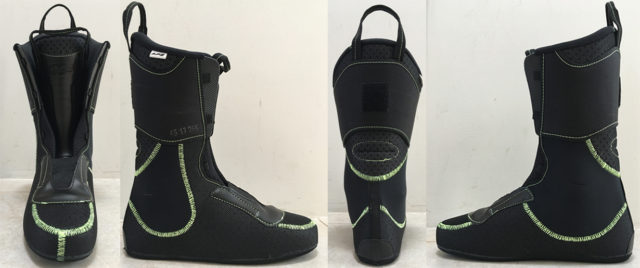
Alex: The Ranger Free 130’s liner was where my personal trouble in the boot stemmed from. I felt like the heel pocket didn’t provide enough retention to keep my wider heel in place. Even with a thick piece of “mustache” foam added around the Achilles, I had a hard time finding a nice balance between getting enough room without it feeling sloppy. After molding and adding the mustache, it got better, but there was still lots of motion while touring, resulting in massive heel blisters.
After examining the liner, I noticed that there were loops for laces on the liner. I’m not sure why Fischer didn’t include laces because, in my case, adding them dramatically improved the fit as well as the flex pattern (more on that later).
After adding laces, my heel blisters were reduced, and after another round of heat molding and more foam around the achilles, I think that I’ve eliminated the blistering issue completely. Overall, my problems with the liners stem from two things: (1) my foot and the fit of the boot simply not being a great match and (2) the lack of laces when there are loops for them. For me, laces improve both the uphill and downhill capabilities of this boot, so I’d highly recommend adding them.
Walk Mechanism — Engagement and Range of Motion
Paul: We’ve come to like the simplicity and reliability of the increasingly ubiquitous external, spring-loaded walk mechanism used on boots like the Atomic Hawx Ultra XTD, 18/19 Tecnica Zero G Tour Pro, and Scarpa Maestrale RS, so I was a little surprised that Fischer decided to go with an internal system on the new Ranger Free 130.
However, I’ve been impressed by the Ranger Free 130 ’s walk mode. It can be activated very easily via a small metal lever that lies just under, and flush with, the top buckle (see image below). I have had no issues engaging either walk or ski mode, and it became second nature to just flip the walk mode when I flipped the buckle. This was especially nice for the more fast-paced nature of sled skiing when doing fast laps with minimal transition time.
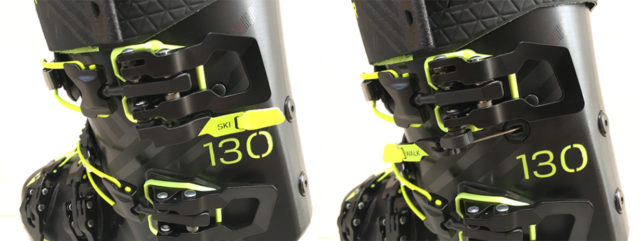
The Ranger Free 130’s walk mode (all of the “Ranger Free” and “My Ranger Free” boots share the same walk mode) has very little play, and I have had zero issues with the boot going in or out of tour mode unintentionally. I do worry that it’s a little more mechanically complicated than other boots out there, and subsequently might be a little more prone to durability issues. But I have had no issues so far. I’ll update this if I experience any unusual problems.
Alex: I love the walk mechanism on this boot. I started skeptical, but for the wrong reasons. The range of motion is much larger than the “free touring” boots I’ve used (e.g., Black Diamond Factor, the old Lange XT 130, and Technica Cochise 130), and the liner and hinge mechanism make the cuff rotation on the Ranger extremely low resistance and smooth.
I had initially worried that the large rear rotation of the cuff in walk mode would make the boot un-skiable if I forgot to put it into ski mode, or if the mechanism broke. But when fully buckled down with the walk mechanism still in touring mode, the range of motion is reduced to what I’d call “skiable articulation.” I found this out by (1) forgetting to put the walk mechanism in ski mode, and (2) experiencing trouble with the mechanism not engaging during a severely cold day.
While it was frustrating to not be able to lock it into ski mode, buckling down the boot gave me enough support to ski (granted, in very nice conditions). And the blockage must have cleared out on its own because, by the end of the descent, the boot had locked into ski mode. I didn’t think much of it at the time, as I had encountered the same issue on other boots. Sometimes gear malfunctions and it is good to know that, even if the walk mechanism were to fail or not lock, the boot is still skiable with the buckles tightened. So far, I’ve only experienced issues with the walk mechanism not locking into ski mode a couple times, and Paul hasn’t had any issues. But if this continues to be a problem in the future, I’ll be sure to update this review.
What really made me love the walk mechanism on the Ranger Free is the location of the switch. While maybe not as easy to get to as the traditional location at the Achilles (you’ll have to hike up your gaiters to actuate it), the Ranger Free’s walk mechanism is almost impossible to flip unintentionally. But even more exciting for me was that, if you are wearing crampons, you can easily transition between a stiff boot and one that you can nimbly tiptoe around in, all without removing your crampons since the Ranger Free’s walk mechanism doesn’t conflict with crampons’ heel bails.
The inaccessibility of traditional walk mechanisms when wearing crampons is being addressed by some crampon manufacturers by relocating the crampon’s cam binding to the toe. But I think the Ranger Free’s walk mechanism location is by far the better solution as you can get the secure crampon mount at the heel (I don’t want moving parts on my toe when I’m kicking ice…) and have a much wider variety of crampons to choose from, rather than just those with cams on the toe.
Soles
Paul: Rather than a rockered, full-rubber touring sole, the Fischer Ranger Free 130 uses GripWalk soles (similar to the Atomic Hawx Ultra XTD, Nordica Strider Pro, Head Kore 1, and many other 50/50 boots on the market).
Over the past few years, we’ve seen an increasing number of boots featuring Walk to Ride or GripWalk soles, which are essentially thickened and rubberized alpine soles that are slightly rockered for easier walking. In reality, it sometimes seems like the difference between these soles and standard alpine soles is only noticeable when walking on flat surfaces like parking lots. While walking / scrambling around the mountains, the GripWalk soles still feel much more like regular alpine soles than the shorter, fully rubberized, and more rockered soles of dedicated AT boots.
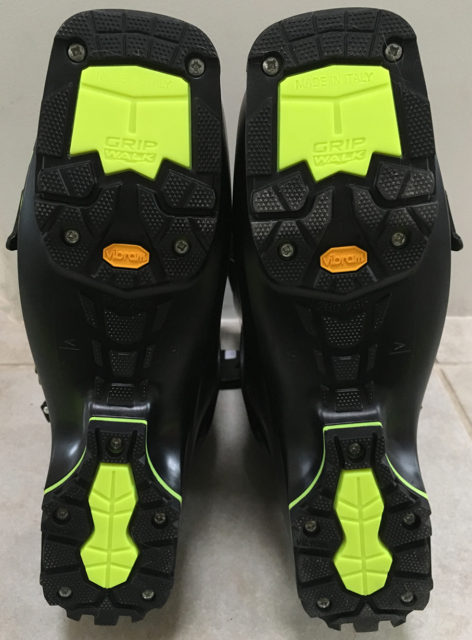
One major downside of GripWalk is that if you buy boots that don’t have the option of swapping the GripWalk soles for traditional alpine sole blocks, you’ll need to make sure that all of your bindings are GripWalk-compatible. (The Ranger Free does not come with alternate sole blocks, but people will be able to purchase alpine sole blocks separately.) For some skiers, this could mean that if you get Ranger Free 130 as a 1-boot quiver (as Fischer suggests), you may also need to buy new bindings for any skis that don’t already have GripWalk-compatible bindings on them.
Of course, all boots that use any sort of rockered and/or rubber sole that falls outside of the ISO 5355 alpine boot norm will face a similar issue (i.e., you’ll need to get bindings that accommodate the different boot sole norm). However, rockered, full-rubber touring soles provide significantly more grip and better walkability compared to GripWalk soles. So, the tradeoff between binding compatibility and improved walkability makes a bit more sense with full-rubber touring soles since they actually provide a very noticeable improvement over traditional alpine soles when it comes to grip while scrambling on snow, ice, rocks, etc.
And it is worth noting that we will be seeing an industry-wide change to the GripWalk norm, with Walk to Ride options not being available within the next few years. This should make it easier to find bindings that are compatible with GripWalk soles.
Alex: For most of the walking that I did in these boots the soles were fine, but, as Paul noted, they feel more similar to traditional alpine soles than they do to full-rubber, rockered touring soles. The Ranger Free’s large AFD pad (that giant yellow section on the toe in the above picture) that says “Grip Walk” is the least grippy thing on the sole as it’s designed to create low-friction interface between a Grip Walk binding and the boot.
The rubber on the rest of the Ranger Free’s soles provides grip on uniform surfaces. But on irregular surfaces such as rocks that you have to scramble over, the Ranger Free’s AFD creates a large and slippery area that you will learn to avoid putting pressure on. If companies keep putting Grip Walk soles on touring boots, I’d like to see if they could make improvements to the interface to improve scrambling / walking performance.
I did notice a tendency for the rubber to break off around the edges of the sole, but I only noticed because the little chunks of rubber temporarily blocked the pin inserts on the boot (rather than further compromising traction). I consider this normal wear while scrambling over sharp rocks.
Fit
Paul: As always, we strongly recommend that you work with your best local bootfitter to figure out what boot best works for your foot.
With that important caveat aside, I am overall pleased with how the Fischer Ranger Free 130 fit my feet (described by bootfitters as being low-volume, skinny heel, high instep, and average to slightly-wide forefoot). The Ranger Free 130’s ample room in the instep was especially nice as this is often a problem area for me and consistently causes me issues in many boots on the market. The Ranger Free 130’s heel pocket is probably not the tightest and most contoured I’ve used, but it provides very good retention for my skinny heels and bony ankles.
In the forefoot and toe area, the Ranger Free 130 is pretty average in width and, as usual for me, required a small 6th toe punch to be tolerable for long days in the boots.
Alex: I’ve spent most of the past few years in some wider-last boots, including the Black Diamond Factor (102 mm) and Technica Cochise 130 (99 mm), and was pretty happy overall with the midfoot width of the Ranger Free 130.
That said, my wider heel did not feel very secure in the Ranger Free 130, and, as I noted above, I ended up adding padding and heel lifts to attempt to secure my heel in the boot. It took some work with both SOLE Boot Labs in Chamonix and our own Kara Willard at Taos’s Boot Doctors to get the fit dialed in, and the adjustments have been (so far) limited to the liner.
To me, the shell itself felt like it was fairly large in the heel and pretty tight in the toes. With the caveat of wearing the boot with only liner work done, my notes at the end of my trip to France said: “While I could use them for six days of consecutive touring, it was only through the knowledge that (sadly ) there wasn’t a seventh day that I could endure the pressure in the toe box.” I should take up Paul’s suggestion of the 6th toe punch!
So, the bottom line here is that, as always, please just go to a bootfitter to figure out what boot will best fit your feet. Because as you can see by Paul and my fit notes, everyone’s feet are different, and just because a boot has a certain last or someone says it works for their feet, doesn’t mean it’ll necessarily work well for yours.
Touring
Paul: I’ve only had the chance to do a few tours on the Ranger Free 130 so far, but have put enough miles on them to get a pretty good idea of their overall touring performance. The boot’s range of motion feels completely adequate for anything I do, and even after recently using boots like the Scarpa Alien RS (which offers more ROM than I could ever use), the Ranger Free 130 doesn’t feel restrictive, even when taking longer strides across the flats.
The Ranger Free 130’s tech fittings came with the Dynafit Certified seal and have been easy to clip into both Dynafit and Fritschi tech bindings.
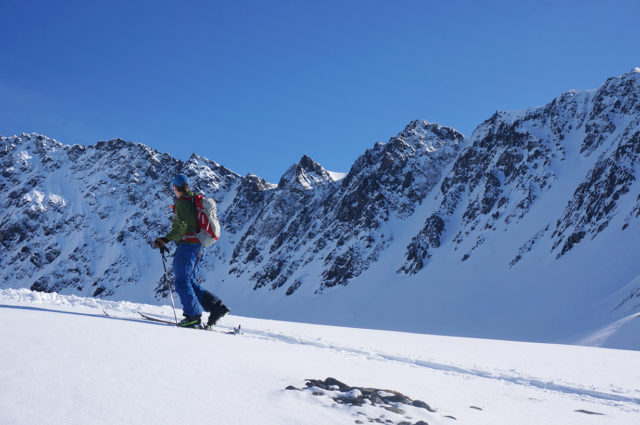
The Ranger Free 130’s four buckles are fairly traditional for a boot in this class, and the upper buckles include an extra hook on the end to use while touring so you can maintain a loose fit while still having the buckles latched / secured. I typically tour with all buckles completely unlatched, and this works fine with the Ranger Free 130. This is likely in part due to how well it holds my heel, even without any buckles tightened.
The only issue I’ve had with the Ranger Free 130 on the up is that I cannot figure out a way to stop various parts of the upper and lower cuffs from clicking together when the cuff rotates through its travel. I’ve tried all kinds of buckled and unbuckled configurations but, so far, have not been able to stop them from clicking. This is a little annoying and is definitely palpable on every step. I’ll keep working on it and update this review if I can figure it out. Maybe it’s related to how my fairly thick shins, high instep, and big calves push on the shell, but I don’t have this issue in many other boots.
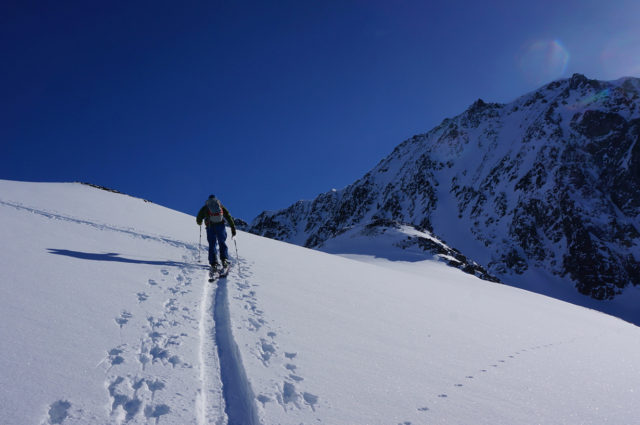
I also used the Ranger Free 130 for a bit of sled skiing and found the GripWalk soles to provide good grip on the sled. I would have preferred a sole with a rubberized instep/arch area, but that would probably add a fair bit of weight for not a ton of benefit while on the sled. (The benefit of a full-rubber sole is more noticeable while scrambling on rocks, ice, etc.)
Alex: I wish I could have tried these out on a sled! I did tour with them in a variety of settings and was very happy with their climbing performance. I have to caveat this with saying that I have never toured in a ski-mo boot, so I don’t know the feeling of skinning with boots lighter than my street shoes.
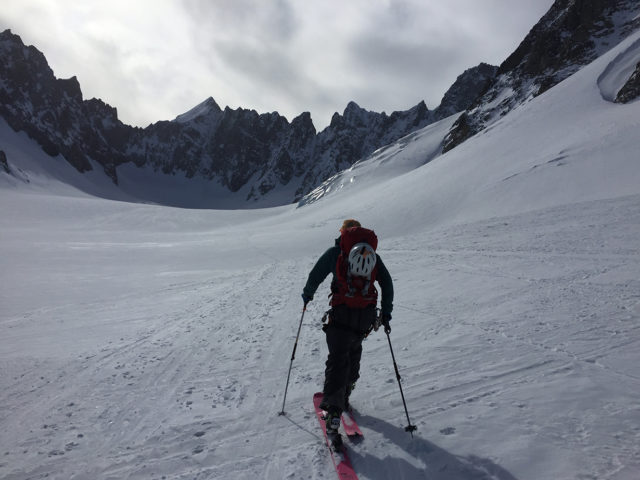
I’ve done all my skinning in heavier, more downhill-oriented AT boots like the Lange XT, BD Factor, and Tecnica Cochise, and the Ranger Free 130 was by far the lightest I’ve used and has the largest articulation range while in walk mode. I could get into as long of a stride as was comfortable for me without being impeded by the boot. With the buckles opened on the least-tight latches, I was comfortable while walking – once I had figured out to put laces on the liner and get a better fit. Before that, I had trouble with my heel lifting (see the liner section above).
As I mentioned in the walk mechanism section, these boots performed extremely well in crampons. In my opinion, the ability to easily switch between walk and ski mode while wearing crampons is one of the strong points of the boot.
Flex Pattern
Paul: We’ve written pretty extensively about how subjective and variable flex ratings can be, and the Ranger Free 130 is another example of the inconsistency between boots and brands. My first runs in these boots were at Alyeska on a ~30°F afternoon of skiing crud, chop, bumps, and groomers. On this day, I was immediately surprised by how much forward flexion I felt in the cuff of the Ranger Free 130 before the boots finally stiffened up. More than most other boots I’ve used in recent memory, the Ranger Free 130 has a very linear flex pattern until my ankles (and the boot) is flexed quite far forward, at which point the flex ramps up pretty abruptly. It took me a little while to get used to, but I have pretty flexible ankles and was able to make it work, albeit with some stance adjustment to accommodate for how far I was flexing forward. On several occasions while skiing very fast in variable snow, I found myself flexing so far through the boot that I got dangerously close to going over my tips.
Given that (a) I’m 190 lbs and 6′ tall, (b) was skiing fast in relatively warm temps, and (c) was on firm, bumpy inbounds conditions on long, stiff skis, it’s certainly possible that I’m at the upper limit of what a 130 flex boot should handle. However, during the same day that I found myself flexing so far through the Ranger Free 130, I had also been heli-ski guiding with my 25 lb guide pack in the Lange RX 130 — a much heavier, alpine boot with a riveted cuff / no walk mode — and felt that the much more progressive flex of the RX 130 offered significantly more forward support.
I need to do some more side-by-side testing, but my preliminary assessment is that in terms of forward flex, the Ranger Free 130 is softer and flexes more linearly than the 17/18 Tecnica Zero G Pro Guide, Salomon S/Lab MTN, and both the 18/19 Lange XT Free 130 LV and the XT Free Promodel LV (140 flex). The overall forward stiffness of the Ranger Free 130 is more comparable to the 17/18 Scarpa Maestrale RS than it is to the boots mentioned above.
I’m also curious to see how the Ranger Free 130 feels vs. some of the 3-piece alpine and 50/50 boots on the market, as those boots have been known to have more linear flex patterns than most 2-piece overlap boots.
Laterally and rearward, the Ranger Free 130 does feel very supportive and easily capable of driving big skis at higher speeds. The more linear forward flex will just take some adjustment for many people coming from stiffer or more progressive boots.
While the forward flex is not as stiff as other boots in this class, the Ranger Free 130’s rearward flex is much more like that of a “130 flex” alpine boot. I had no trouble pulling myself out of the backseat in these boots, even at higher speeds and with my touring pack on. In this regard, the Ranger Free 130 is significantly stiffer than dedicated touring boots like the Maestrale RS or Dynafit Vulcan, and quite comparable to the 17/18 Zero G Pro Guide or S/Lab MTN.
Alex: From my experience, I’ve never been in a touring boot with a flex that 100% matched that of a strong, dedicated alpine boot. I will also tell you that I do not believe that there is a single boot, ski, or binding quiver. The demands of touring, ski mountaineering, ski-mo racing, alpine skiing, and alpine racing are so different that you will give up performance in one for gains in the other.
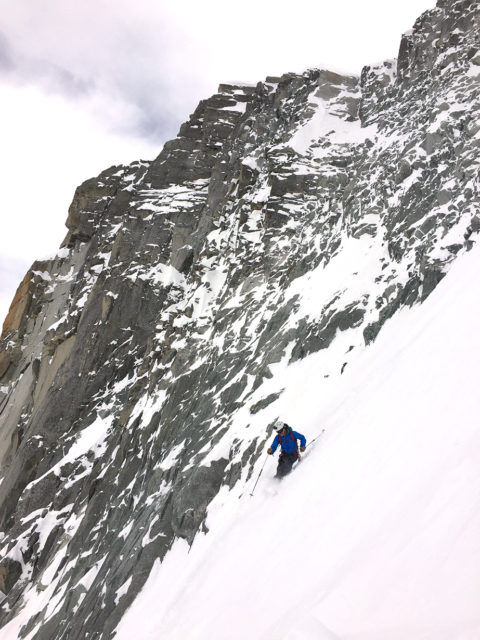
My opinion on this doesn’t change with to the Ranger Free 130, but I think it is quite good on the downhill for a touring boot. To me, the flex pattern of the boot feels like it starts soft and ramps up to a solid finish as you get deep into the flex. This is a great departure from other boots that I’ve been in that would start stiff, and then collapse under pressure. For reference, I’m 6’0”, ~170 lbs.
The Ranger Free 130’s softer initial flex can be stiffened up a bit with the aforementioned laces being added to the liner, as the majority of the early movement I had in the boot seemed to be due to the liner not actually supporting the tongue when not laced. While adding laces stiffens this early flex, it doesn’t eliminate it, which I’m happy about.
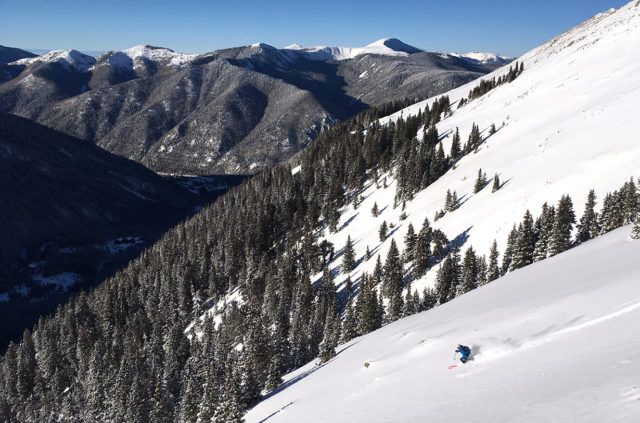
Skiing the boot in the resort in challenging, bumpy conditions on a ski that requires some force (the old Black Crows Corvus) left me wishing for my alpine boot. But these were challenging conditions, and I would say the Ranger Free 130 would work well for most inbounds skiing conditions and terrain, especially if you restrict yourself to only skiing it on powder days, corduroy, or other forgiving conditions.
While I wouldn’t choose the Ranger Free 130 as my dedicated alpine setup, I really like the way these boots ski in backcountry conditions, which made up 95% of the skiing that my pair saw. I have been lucky enough to not have had a day of really bad snow while touring in the Ranger Free 130, but I felt that the boot handled deep snow, variable conditions, fast lines, and heavy, sun-effected snow really well for its weight.
The more I was able to get the fit right, the more the Ranger Free 130 impressed me (not a surprise). These boots will not provide the power of a true 130-flex alpine boot for sending it in the resort, but the support they give you for the weight you will be dragging up the skin track is quite good.
Snow / Ski Feel
One thing that did immediately standout with the Ranger Free 130 is that it provides the most snow / ski feedback of any boot I’ve used. I’m not sure if the Ranger Free 130 is a bit thinner in the soles or if it’s related to some other material or construction, but I’ve enjoyed feeling the texture of the snow through my boots, and I think it might help me ski a little better as result.
Alex: I agree. The combination of the Ranger Free 130’s lightweight liner and thin shell definitely provided feedback, especially when combined with tech bindings. I came to like the flex pattern that I described above, with the boot starting “soft” and increasing in resistance. It allowed for a more mellow, easy engagement of the ski in soft conditions, but then I could drive the ski harder as I got deeper into the flex of the boot and reached the more resistant point in its flex, should the conditions change during a pitch.
Who’s It For?
While boots like the Salomon S/Lab MTN and Atomic Hawx Ultra XTD 130 are stiffer in forward flex, the Fischer is still a very good boot with a legitimate touring mode, great liner, and plenty of support for the majority of situations (especially if you’re lighter than I am). The fit and ergonomics of the boot work well for me, and I’d be happy to have it as a beefy touring boot that can do double-duty at the ski resort — so long as I’m willing to dial back my skiing a bit in certain situations. Big skiers who want the stiffest, burliest touring boot on the market might be better off with another boot, unless they want a deep, linear flex.
Bottom Line
The 18/19 Fischer Ranger Free 130 is a well-designed boot that tours well, has a nice liner, and offers a softer, deeper, more linear flex pattern than other “130” boots in this category. All of this, combined with its competitively low weight and overall ease of use makes it another solid option in the growing class of boots designed to handle everything from big tours to long days of riding lifts.

Fischer does have DIN soles available. They’re are actually the same sole as the RC4 Curv boot.
I have a pair of Ranger Free 130’s and absolutely love them so far!!
I would love to see a comparison between the Ranger Free 130 and the Atomic Hawx Ultra XTD 130
Any more updates to this review coming soon? i have my eyes on a pair.
I purchased a pair of Ranger Free 130s this fall, and my wife purchased the women’s version (i.e. 110s) as well. We have both encountered the same defect which I’d like to report to others. Inside the shell, the manufacturer placed round stickers over the ankle hinge points that are meant to prevent the liner from rubbing against, I suppose, the edges of the shell and the ankle hinge mechanism. Well, the sticker doesn’t work…basically at all. After only three sidecountry laps, the ankle areas on both sides of my liners are getting munched, and the sticker they put on the inside of the shell is also peeling away. Mine are worse, but my wife who only weighs 100 lbs (lighter on her equipment than I) is also seeing the same issue beginning to occur on her liners after a couple of days of sidecountry/touring action. Fischer is apparently aware of the problem and is trying to figure something out to respond to this issue, so evidently I’m not the only one encountering the problem. Otherwise, I do enjoy their relatively ample instep, and somewhat narrow last. I did have to perform a small punch for the 7th toe area (the little bone that generally protrudes along the side of your foot just ahead of your heel). The calf fit is also a bit higher and a bit tighter than would be my personal preference, but I’m trying to deal with that. The forward flex also takes a bit of adjustment, but laterally and rearward flex does seem stiff and responsive thus far. They are a bit ‘cool’ on the temperature scale, which might be somewhat expected due to their thinner plastic and lighter weight. All in all, I do still prefer my regular old resort boots for frontside days. These, if they fix the shell/liner durability issue, will become my sidecountry boots, and ones I may use for some medium distance touring-days. I hesitate to believe these “do it all” boots would stand up to the rigor of skiers like myself, who skis a tough mountain with highly variable terrain in British Columbia 40-50 days per season (quite a number of days including sidecountry laps as well), plus another dozen or more touring days, as a “do it all” boot. Thats my two cents.
Good feedback thanks! Gorilla tape outta do it. That 7th toe is called the cuboid. Have fun out there!!
I had these for a day and it was a disaster. Tried them at first in fairly icy conditions with my 115m freeride skis with g3 ion12. Straight out of the lift after 2 turns I had to stop and see if I forgot to put them in ski mode as they would just let go when pushed. I actually stopped several times , and even took them off the check that they where truly locked . they would start flexing very soft and then they just would straightaway colapse forward. Now I’m a big guy at 6″2 and 230lbs so may not be enough meat on these to keep me from going over the bars. As a reference I usually use the dalbello lupo ax120 and scarpa maestrale rs . They are both similar to flex . The dalbello is not so progressive as the scarpa and when pushed maybe the scarpa is a bit stiffer . I really want to try the atomic hawk to se if I could find a stiff and light boot . Otherwise it is back to the almost 2kg class og touringorientated alpine boots.
Any plans to take a look at the Alpine/Touring boot that Fischer released, the Ranger One? It seems to have some distinct differences than the other boots in that category. Thanks!
Interesting to hear your thoughts on the liners. IMO that’s kinda where the idea of a 50/50 boot, and especially this one in particular fails, it should come with two liners, one for warm touring days, and another warmer one for colder or resort days (where I found them to be way too cold). Unfortunately I can’t find a warmer liner that will work with them because I sized them for the original ones. Plus it’s kinda crazy there’s nothing to block the snow from getting into the heel area.
I tried on the updated version of these alongside every other 130 flex boot in the shop, including the rx130 – and I was able to flex through every other boot easier than this one.
Bought them.
Now up on the hill regretting it as they definitely flex way too soft.
Has anyone had the Liners Pack-Out and become sloppy after 80 days of skiing?